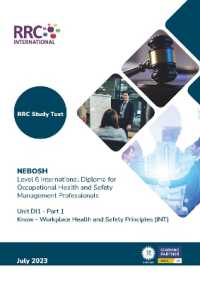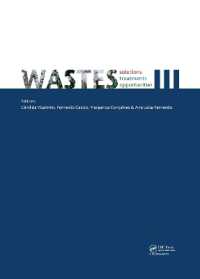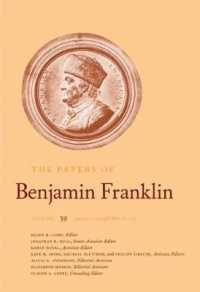Full Description
The desire of governments for a 'renaissance' of their cities is a defining feature of contemporary urban policy. From Melbourne and Toronto to Johannesburg and Istanbul, government policies are successfully attracting investment and middle-class populations to their inner areas. Regeneration - or gentrification as it can often become - produces winners and losers. There is a substantial literature on the causes and unequal effects of gentrification, and on the global and local conditions driving processes of dis- and re-investment. But there is little examination of the actual strategies used to achieve urban regeneration - what were their intents, did they 'succeed' (and if not why not) and what were the specific consequences?
Whose Urban Renaissance? asks who benefits from these urban transformations. The book contains beautifully written and accessible stories from researchers and activists in 21 cities across Europe, North and South America, Asia, South Africa, the Middle East and Australia, each exploring a specific case of urban regeneration. Some chapters focus on government or market strategies driving the regeneration process, and look closely at the effects. Others look at the local contingencies that influence the way these strategies work. Still others look at instances of opposition and struggle, and at policy interventions that were used in some places to ameliorate the inequities of gentrification. Working from these stories, the editors develop a comparative analysis of regeneration strategies, with nuanced assessments of local constraints and counteracting policy responses. The concluding chapters provide a critical comparison of existing strategies, and open new directions for more equitable policy approaches in the future.
Whose Urban Renaissance? is targeted at students, academics, planners, policy-makers and activists. The book is unique in its geographical breadth and its constructive policy emphasis, offering a succinct, critical and timely exploration of urban regeneration strategies throughout the world.
Contents
1. Introduction (Libby Porter and Kate Shaw) Part 1: On Urban Renaissance Strategies Case Study: Top Down Vs. Bottom Up: Doreen From Silwood, a Social Housing Estate in South London (Mark Saunders) 2. Class-cleansing in Istanbul's World-city Project (Ibrahim Gündogdu and Jamie Gough) 3. Believing in Market Forces in Johannesburg (Tanja Winkler) 4. Regeneration through Urban Mega-projects in Riyadh (Tahar Ledraa and Nasser Abu-Anzeh) 5. Regulation and Property Speculation in the Centre of Mexico City (Beatriz García-Peralta and Melanie Lombard) 6. Museumization and Transformation in Florence (Laura Colini, Anna Lisa Pecoriello, Lorenzo Tripodi and Iacopo Zetti) 7. Winners and Losers from Urban Growth in South East England (Bob Colenutt) Part 2: On Local Limits to Regeneration Strategies Case Study: When Fish Sing in Brussels (Ruth Pringle) 8. Renaissance through Demolition in Leipzig (Matthias Bernt) 9. Image Politics and Stagnation in the Ruhr Valley (Sebastian Müller and Constance Carr) 10. Gentrification and the Creative Class in Berlin-Kreuzberg (Ingo Bader and Martin Bialluch) Part 3: On Grass-roots Struggles Case Study: Gathering Memories at the Battlefront: www.oldbeijing.org (Yi Jing, Giovanni Allegretti and James McKay) 11. The Contested Reinvention of Inner City Green Bay, Wisconsin (Marcelo Cruz) 12. Planning From Below in Barcelona (Marc Martí-Costa and Jordi Bonet-Martí) 13. The Ambiguous Renaissance of Rome (Giovanni Allegretti and Carlo Cellamare) 14. Struggling Against Renaissance in Birmingham's Eastside (Libby Porter) 15. Urban Renaissance and Resistance in Toronto (Ute Lehrer) 16. Gentrification and Community Empowerment in East London (Claire Colomb) Part 4: On the Possibilities of Policy Case Study: Gertrude Street Fitzroy (Rodger Cummins and Kate Shaw) 17. Heritage Tourism and Displacement in Salvador da Bahia (Elena Tarsi) 18. Retail Gentrification in Ciutat Vella, Barcelona (Núria Pascual-Molinas and Ramon Ribera-Fumaz) 19. The Melbourne Indie Music Scene and the Inner City Blues (Kate Shaw) 20. The Embrace of Amsterdam's Creative Breeding Ground (Bas van de Geyn and Jaap Draaisma) 21. The Equitable Regeneration of Berne (Angela Stienen and Daniel Blumer) 22. Searching for the 'sweet spot' in San Francisco (Peter Cohen and Fernando Martí) Case Study: Bottom Up Vs. Top Down: Jess From Pepys, a Social Housing Estate in South London (Mark Saunders) Part 5: New Theoretical and Practical Insights for Urban Policy 23. Whose Urban Renaissance? (Libby Porter) 24. Rising to a Challenge (Kate Shaw)








